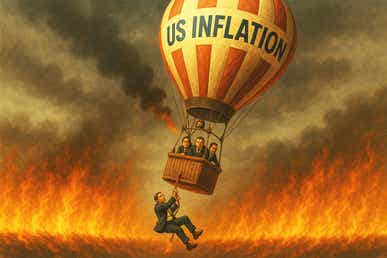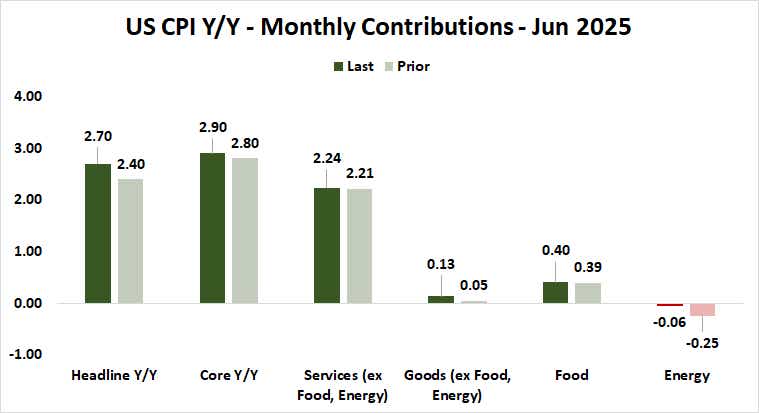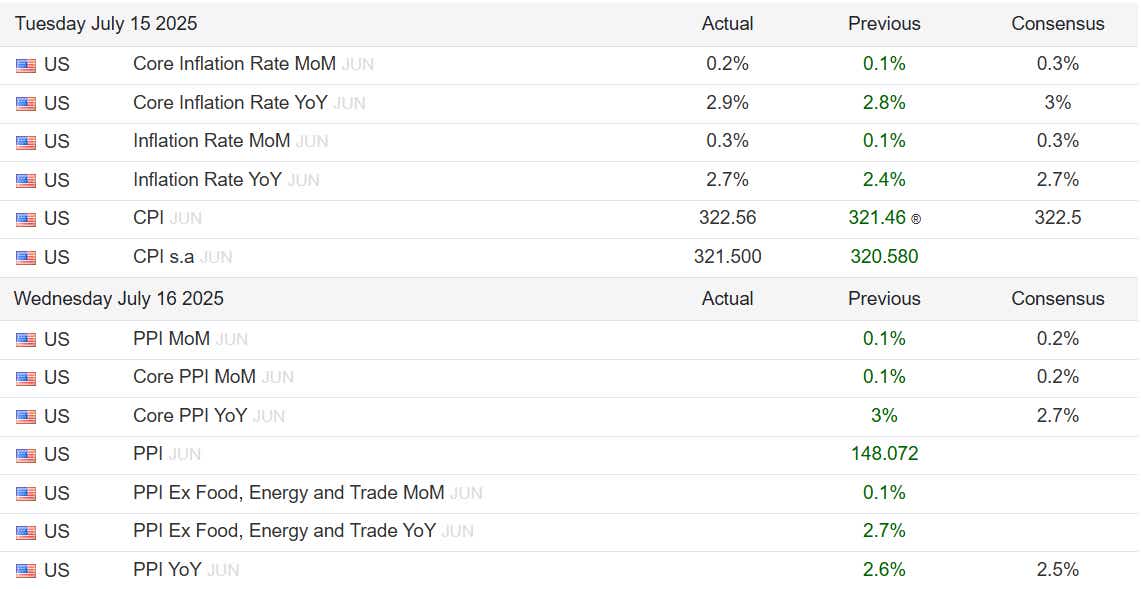Stocks Under Fire, Dollar Up as Markets Finally Face Tariff Inflation

Stocks Under Fire, Dollar Up as Markets Finally Face Tariff Inflation
By:Ilya Spivak
The markets jeered as US consumer prices showed early signs of tariff-linked inflation. More pain may be ahead.
- June US CPI data appears to show first signs of tariff-linked inflation rise
- Stocks fall, dollar gains as traders wind back 2025 Fed rate cut outlook
- The market mood may sour further if PPI data points to shrinking margins
US inflation perked up in June, as expected. The headline consumer price index (CPI) rose 2.7% year-on-year, matching economists’ forecasts. The core measure excluding volatile food and energy prices – the focus for Federal Reserve officials – came in at 2.9%, a touch lower than the 3% penciled in ahead of the release.
These outcomes mark the fastest US price growth in four months. The core services sector remained the biggest contributor, accounting for 2.24 percentage points (ppt) of the headline reading. Core goods notably perked up, however. While the increase here was just 0.13ppt, this was also the biggest uplift from the sector since July 2023.
US consumer prices data reveals first signs of tariff-linked inflation
Monthly changes in contribution measures make the point more emphatically still. The upside push from the core services side of the ledger increased by 0.02ppt from May to June. It was 0.08ppt from core goods, suggesting a stronger inflationary thrust on that side of the ledger.

This might imply that the belated influence of the many tariff policies introduced by the Trump administration since the beginning of the year are finally beginning to appear in the data. The markets seemed to interpret the data as such, with price action suggesting the result will limit scope for Fed interest rate cuts in the near term.
Benchmark Fed Funds futures now price in 38 basis points (bps) in cuts this year, marking the least dovish reading in five months. The implied path for 2026 has moved in the opposite direction, with 67.5bps now on the menu. That is the most dovish since the underlying futures contracts began trading three years ago.
Markets rejected US CPI data, and PPI may bring more of the same
Traders were pointedly displeased. Stocks finished the session with losses despite probing new record highs intraday. The S&P 500 closed down 0.43% having traded up as much as 0.51%, while the Nasdaq 100 finished flat, erasing a rally of as much as 0.81%. The small-cap Russell 2000 fell 1.95%, its biggest daily loss in two months.

Treasury bond yields rose across the curve while gold prices fell, although the metal managed to hold within its three-week range. The US dollar roared higher, buoyed by higher rates and reclaiming its mantle as a defensive asset in risk-off markets. Cycle- and sentiment-sensitive crude oil and bitcoin prices fell.
June’s producer price index (PPI) data is up next. A downtick in wholesale price growth is expected, but traders will be keen to see where it comes from in the report’s internals. If weakness is driven by further compression of wholesalers’ margins as firms try to insulate consumers from tariff-linked price hikes, the markets may jeer louder.
Ilya Spivak, tastylive head of global macro, has 15 years of experience in trading strategy, and he specializes in identifying thematic moves in currencies, commodities, interest rates and equities. He hosts #Macro Money and co-hosts Overtime, Monday-Thursday. @Ilyaspivak
For live daily programming, market news and commentary, visit #tastylive or the YouTube channels tastylive (for options traders), and tastyliveTrending for stocks, futures, forex & macro.
Trade with a better broker, open a tastytrade account today. tastylive, Inc. and tastytrade, Inc. are separate but affiliated companies.
Options involve risk and are not suitable for all investors. Please read Characteristics and Risks of Standardized Options before deciding to invest in options.
tastylive content is created, produced, and provided solely by tastylive, Inc. (“tastylive”) and is for informational and educational purposes only. It is not, nor is it intended to be, trading or investment advice or a recommendation that any security, futures contract, digital asset, other product, transaction, or investment strategy is suitable for any person. Trading securities, futures products, and digital assets involve risk and may result in a loss greater than the original amount invested. tastylive, through its content, financial programming or otherwise, does not provide investment or financial advice or make investment recommendations. Investment information provided may not be appropriate for all investors and is provided without respect to individual investor financial sophistication, financial situation, investing time horizon or risk tolerance. tastylive is not in the business of transacting securities trades, nor does it direct client commodity accounts or give commodity trading advice tailored to any particular client’s situation or investment objectives. Supporting documentation for any claims (including claims made on behalf of options programs), comparisons, statistics, or other technical data, if applicable, will be supplied upon request. tastylive is not a licensed financial adviser, registered investment adviser, or a registered broker-dealer. Options, futures, and futures options are not suitable for all investors. Prior to trading securities, options, futures, or futures options, please read the applicable risk disclosures, including, but not limited to, the Characteristics and Risks of Standardized Options Disclosure and the Futures and Exchange-Traded Options Risk Disclosure found on tastytrade.com/disclosures.
tastytrade, Inc. ("tastytrade”) is a registered broker-dealer and member of FINRA, NFA, and SIPC. tastytrade was previously known as tastyworks, Inc. (“tastyworks”). tastytrade offers self-directed brokerage accounts to its customers. tastytrade does not give financial or trading advice, nor does it make investment recommendations. You alone are responsible for making your investment and trading decisions and for evaluating the merits and risks associated with the use of tastytrade’s systems, services or products. tastytrade is a wholly-owned subsidiary of tastylive, Inc.
tastytrade has entered into a Marketing Agreement with tastylive (“Marketing Agent”) whereby tastytrade pays compensation to Marketing Agent to recommend tastytrade’s brokerage services. The existence of this Marketing Agreement should not be deemed as an endorsement or recommendation of Marketing Agent by tastytrade. tastytrade and Marketing Agent are separate entities with their own products and services. tastylive is the parent company of tastytrade.
tastyfx, LLC (“tastyfx”) is a Commodity Futures Trading Commission (“CFTC”) registered Retail Foreign Exchange Dealer (RFED) and Introducing Broker (IB) and Forex Dealer Member (FDM) of the National Futures Association (“NFA”) (NFA ID 0509630). Leveraged trading in foreign currency or off-exchange products on margin carries significant risk and may not be suitable for all investors. We advise you to carefully consider whether trading is appropriate for you based on your personal circumstances as you may lose more than you invest.
tastycrypto is provided solely by tasty Software Solutions, LLC. tasty Software Solutions, LLC is a separate but affiliate company of tastylive, Inc. Neither tastylive nor any of its affiliates are responsible for the products or services provided by tasty Software Solutions, LLC. Cryptocurrency trading is not suitable for all investors due to the number of risks involved. The value of any cryptocurrency, including digital assets pegged to fiat currency, commodities, or any other asset, may go to zero.
© copyright 2013 - 2025 tastylive, Inc. All Rights Reserved. Applicable portions of the Terms of Use on tastylive.com apply. Reproduction, adaptation, distribution, public display, exhibition for profit, or storage in any electronic storage media in whole or in part is prohibited under penalty of law, provided that you may download tastylive’s podcasts as necessary to view for personal use. tastylive was previously known as tastytrade, Inc. tastylive is a trademark/servicemark owned by tastylive, Inc.